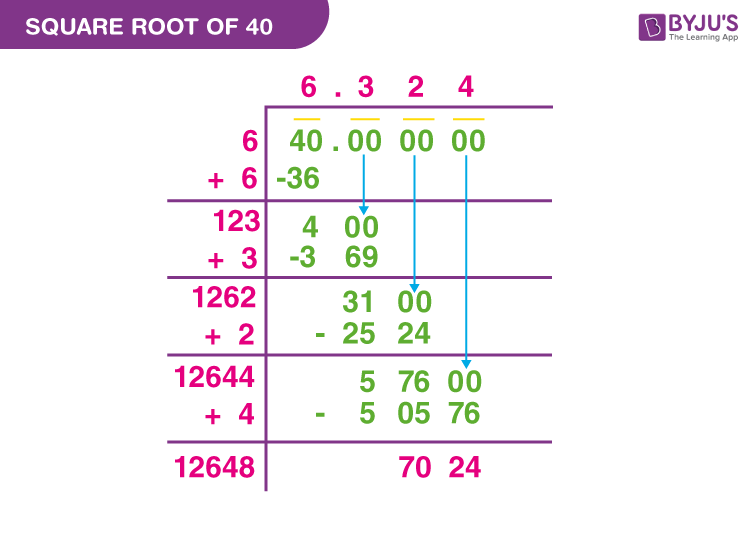In Mathematics, the square root of a number is a number, which when multiplied by itself resulting in the original number. Thus, the square root of 40 is a number, which when multiplied by itself resulting in the original number 40. Since the value of the square root of 40 cannot be expressed in the form of p/q, the square root of 40 is an irrational number. In this article, we are going to discuss the value of square root of 40 and the two different methods to find the square root of 40 are provided here with complete explanation.
What is the Square Root of 40?
If a number is multiplied by itself and gives the result as 40, then the number is the square root 40. The square root of 40 is symbolically expressed as √40.
Hence, √40 = √(Number × Number)
Thus, if we multiply the number 6.3245 two times, we get the original value 40.
(i.e) √40 = √(6.3245× 6.3245)
√40 = √(6.3245)2
Now, remove square and square root, we get
√40 = ± 6.3245.
|
Square Root of 40 in Decimal Form: 6.3245. |
|---|
Square Root of 40 in Radical Form
The square root of 40 can also be expressed in the radical form. If we know the prime factorization of 40, we can write the simplest radical form of the square root of 40. Thus, the prime factorization of 40 is 2 × 2 × 2 × 5. If it is written in the radical form (i.e) √2×√2×√2×√5, we get the simplest radical form of the square root of 40. (i.e) 2√10.
|
Square Root of 40 in Radical Form: 2√10. |
|---|
Square Root of 40 by Prime Factorization Method
To find the square root of 40 using the prime factorization method, first, write the prime factorization of 40. Thus, the prime factorization of 40 is 2 × 2 × 2 × 5.
Thus, √40 = √2×√2×√2×√5
√40 = (√2)2. √2. √5
√40 = (2). √2. √5.
We know that,
√2 = 1.414
√5 = 2.236
Now, substitute the values of √2 and √5 in the above equation.
√40 = 2×1.414×2.236
√40 =6.3245553 (approximately)
Hence, the square root of 40 in decimal form is 6.32456 (rounded to five decimal places)
Square Root of 40 by Long Division Method
The procedure to find the square root of 40 using the long division method is given as follows:
Step 1: Write the number 40 in decimal form. To find the exact value of the square root of 40, add 6 zeros after the decimal point. Hence, 40 in decimal form is 40.000000. Now, pair the number 40 from right to left by putting the bar on the top of the number.
Step 2: Now, divide the number 40 by a number, such that the product of the same number should be less than or equal to 40. Thus, 6×6 =36, which is less than 40. Thus, we obtained the quotient = 6 and remainder = 4.
Step 3: Double the quotient value, so we get 12, and assume that 120 is the new divisor. Now, bring down the value 00 for division operation. So, the new dividend obtained is 400. Now, find the number, such that (120 + new number) × new number should give the product value, that should be less than or equal to 400. Hence, (120+3) × 3 = 369, which is less than 400.
Step 4: Now subtract 369 from 400, and we get 31 as the new reminder, and 63 as a quotient.
Step 5: The new quotient obtained is 63, and double that. Hence, we get 126 and assume that 1260 is our new divisor. Now, bring down the two zeros and, we have 3100 as the new dividend.
Step 6: Find the number, such that (1260 + new number) × new number should give the product value, that should be less than or equal to 3100. Thus, (1260+2)× 2 = 2524, which is less than 3100.
Step 7: Subtract 2524 from 3100, and we get 576 as the new reminder.
Step 8: Continue this process until we get the approximate value of the square root of 40 up to three decimal places. (Note: keep the decimal point in the quotient value after bringing down all the values in the dividend).
Step 9: Thus, the approximate value of the square root of 40, √40 is 6.3245.

| Related Articles: |
|---|
Video Lessons on Square Roots
Visualising square roots

Finding Square roots

Examples
Example 1:
Simplify 100 +√40.
Solution:
Given: 100+√40.
We know that the square root of 40 is 6.3245
Now, substitute the value in the expression, we get:
100+√40 = 100+ 6.3245
100 +√40 = 106.3245
Therefore, 100+√40 is 106.3245.
Example 2:
Simplify 2√10×√40.
Solution:
Given: 2√10×√40
We know that the square root of 40 in the simplest radical form is 2√10.
Now, substitute √40 = 2√10 in the given expression, we get
2√10×√40 = 2√10×(2√10)
2√10×√40 = 4(10)
2√10×√40 = 40.
Hence, the simplified form of 2√10×√40 is 40.
Example 3:
Find the value of a, if a√40 + 10 = 60.
Solution:
Given equation: a√40 + 10 = 60…(1)
We know that √40 = 6.3245.
Now, substitute the value in equation (1), we get
a(6.3245) + 10 = 60
6.3245a = 60-10
6.3245a = 50
a = 50/6.3245
a = 7.9058
Therefore, the value of a is 7.9058.
Frequently Asked Questions on Square Root of 40
What is the value of the square root of 40?
The value of the square root of 40 is approximately equal to 6.3245.
What is the square root of 40 in radical form?
The square root of 40 in radical form is 2√10.
Is the square root of 40 a rational number?
No, the square root of 40 is not a rational number, as it cannot be expressed in the form of p/q.
Is 40 a perfect square?
No, the number 40 is not a perfect square.
What is the value of the square of square root of 40?
The square of square root of 40 is 40.
(i.e) (√40)2 = 40.
Comments